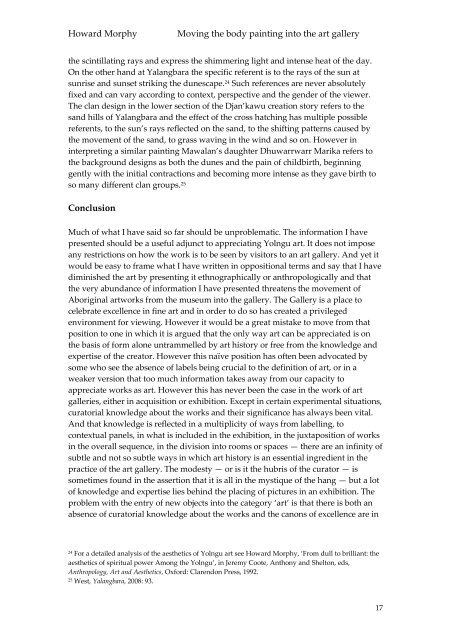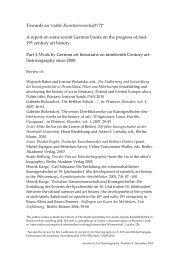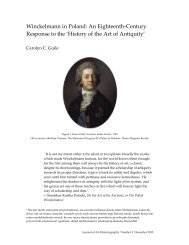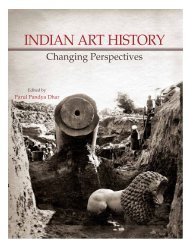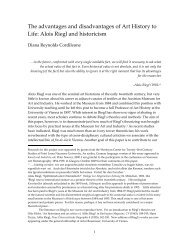Moving the body painting into the art gallery - Journal of Art ...
Moving the body painting into the art gallery - Journal of Art ...
Moving the body painting into the art gallery - Journal of Art ...
Create successful ePaper yourself
Turn your PDF publications into a flip-book with our unique Google optimized e-Paper software.
Howard Morphy <strong>Moving</strong> <strong>the</strong> <strong>body</strong> <strong>painting</strong> <strong>into</strong> <strong>the</strong> <strong>art</strong> <strong>gallery</strong><br />
<strong>the</strong> scintillating rays and express <strong>the</strong> shimmering light and intense heat <strong>of</strong> <strong>the</strong> day.<br />
On <strong>the</strong> o<strong>the</strong>r hand at Yalangbara <strong>the</strong> specific referent is to <strong>the</strong> rays <strong>of</strong> <strong>the</strong> sun at<br />
sunrise and sunset striking <strong>the</strong> dunescape. 24 Such references are never absolutely<br />
fixed and can vary according to context, perspective and <strong>the</strong> gender <strong>of</strong> <strong>the</strong> viewer.<br />
The clan design in <strong>the</strong> lower section <strong>of</strong> <strong>the</strong> Djan’kawu creation story refers to <strong>the</strong><br />
sand hills <strong>of</strong> Yalangbara and <strong>the</strong> effect <strong>of</strong> <strong>the</strong> cross hatching has multiple possible<br />
referents, to <strong>the</strong> sun’s rays reflected on <strong>the</strong> sand, to <strong>the</strong> shifting patterns caused by<br />
<strong>the</strong> movement <strong>of</strong> <strong>the</strong> sand, to grass waving in <strong>the</strong> wind and so on. However in<br />
interpreting a similar <strong>painting</strong> Mawalan’s daughter Dhuwarrwarr Marika refers to<br />
<strong>the</strong> background designs as both <strong>the</strong> dunes and <strong>the</strong> pain <strong>of</strong> childbirth, beginning<br />
gently with <strong>the</strong> initial contractions and becoming more intense as <strong>the</strong>y gave birth to<br />
so many different clan groups. 25<br />
Conclusion<br />
Much <strong>of</strong> what I have said so far should be unproblematic. The information I have<br />
presented should be a useful adjunct to appreciating Yolngu <strong>art</strong>. It does not impose<br />
any restrictions on how <strong>the</strong> work is to be seen by visitors to an <strong>art</strong> <strong>gallery</strong>. And yet it<br />
would be easy to frame what I have written in oppositional terms and say that I have<br />
diminished <strong>the</strong> <strong>art</strong> by presenting it ethnographically or anthropologically and that<br />
<strong>the</strong> very abundance <strong>of</strong> information I have presented threatens <strong>the</strong> movement <strong>of</strong><br />
Aboriginal <strong>art</strong>works from <strong>the</strong> museum <strong>into</strong> <strong>the</strong> <strong>gallery</strong>. The Gallery is a place to<br />
celebrate excellence in fine <strong>art</strong> and in order to do so has created a privileged<br />
environment for viewing. However it would be a great mistake to move from that<br />
position to one in which it is argued that <strong>the</strong> only way <strong>art</strong> can be appreciated is on<br />
<strong>the</strong> basis <strong>of</strong> form alone untrammelled by <strong>art</strong> history or free from <strong>the</strong> knowledge and<br />
expertise <strong>of</strong> <strong>the</strong> creator. However this naïve position has <strong>of</strong>ten been advocated by<br />
some who see <strong>the</strong> absence <strong>of</strong> labels being crucial to <strong>the</strong> definition <strong>of</strong> <strong>art</strong>, or in a<br />
weaker version that too much information takes away from our capacity to<br />
appreciate works as <strong>art</strong>. However this has never been <strong>the</strong> case in <strong>the</strong> work <strong>of</strong> <strong>art</strong><br />
galleries, ei<strong>the</strong>r in acquisition or exhibition. Except in certain experimental situations,<br />
curatorial knowledge about <strong>the</strong> works and <strong>the</strong>ir significance has always been vital.<br />
And that knowledge is reflected in a multiplicity <strong>of</strong> ways from labelling, to<br />
contextual panels, in what is included in <strong>the</strong> exhibition, in <strong>the</strong> juxtaposition <strong>of</strong> works<br />
in <strong>the</strong> overall sequence, in <strong>the</strong> division <strong>into</strong> rooms or spaces — <strong>the</strong>re are an infinity <strong>of</strong><br />
subtle and not so subtle ways in which <strong>art</strong> history is an essential ingredient in <strong>the</strong><br />
practice <strong>of</strong> <strong>the</strong> <strong>art</strong> <strong>gallery</strong>. The modesty — or is it <strong>the</strong> hubris <strong>of</strong> <strong>the</strong> curator — is<br />
sometimes found in <strong>the</strong> assertion that it is all in <strong>the</strong> mystique <strong>of</strong> <strong>the</strong> hang — but a lot<br />
<strong>of</strong> knowledge and expertise lies behind <strong>the</strong> placing <strong>of</strong> pictures in an exhibition. The<br />
problem with <strong>the</strong> entry <strong>of</strong> new objects <strong>into</strong> <strong>the</strong> category ‘<strong>art</strong>’ is that <strong>the</strong>re is both an<br />
absence <strong>of</strong> curatorial knowledge about <strong>the</strong> works and <strong>the</strong> canons <strong>of</strong> excellence are in<br />
24 For a detailed analysis <strong>of</strong> <strong>the</strong> aes<strong>the</strong>tics <strong>of</strong> Yolngu <strong>art</strong> see Howard Morphy, ‘From dull to brilliant: <strong>the</strong><br />
aes<strong>the</strong>tics <strong>of</strong> spiritual power Among <strong>the</strong> Yolngu’, in Jeremy Coote, Anthony and Shelton, eds,<br />
Anthropology, <strong>Art</strong> and Aes<strong>the</strong>tics, Oxford: Clarendon Press, 1992.<br />
25 West, Yalangbara, 2008: 93.<br />
17


